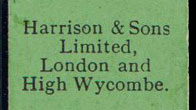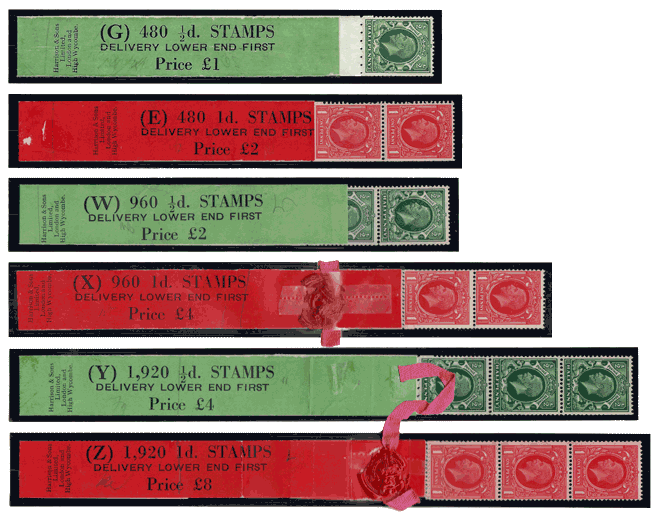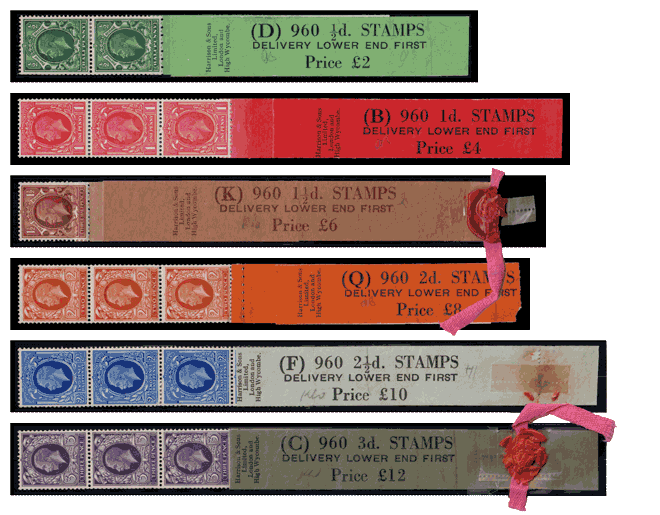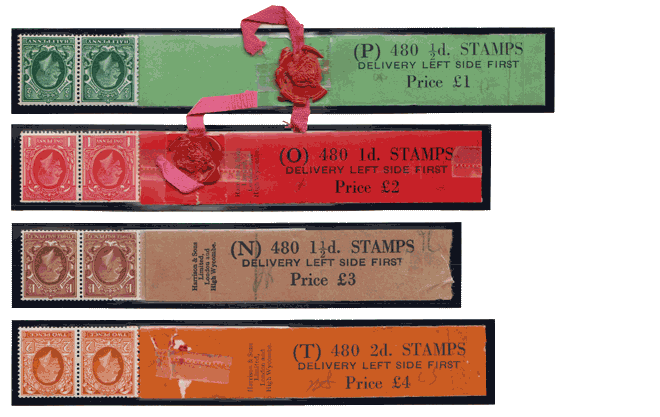
The printing contract changed back from Waterlow to Harrison on 1 Jan 1934 with the promise of upgrading the printing process from Letterpress to Photogravure, a faster and lower cost process using double sized cylinders instead of plates.
Harrison had to purchase another factory site with new printing equipment and it took considerable time to get the new process up and running. Photogravure should have been ideal for printing continuous rolls, but the Post Office had set the priority as sheets first, then booklets, then rolls last. So very few rolls were produced in photogravure during 1934, only some 5,600 (E), 200 (K), and 3,413 (L) rolls, all thought to be Intermediate format but no (K) rolls have survived. To make up for these small numbers, provisional printings were made by both Waterlow and Harrison in letterpress, although only Waterlow could print continuously in letterpress. Harrison did better in 1935, producing over 180,000 photogravure rolls during the first two months.

The printer’s imprint included the new site at High Wycombe.
The size of the photogravure stamp design was reduced twice to allow for more accurate perforation. These sizes are known as Large, Intermediate, and Small formats. Stamps for rolls were produced in only Intermediate and Small formats. While the overall stamp size remained constant at 0.8 x 0.95 inches, the perforation gutter between stamps was increased from 1/16 inch (0.0625″) for large format, to 0.07″ for Intermediate format (different from the 0.075″ for sheet and booklet stamps), to 0.095″ for small format. Additionally, the size of the gutter on sideways stamps was changed to 0.093″ to fit 19.95″ cylinders.
Also of note:
• Rolls (GE) were changed from FIXO (top end) to Post Office vending (lower end).
• Harrison printed provisional (MQS) rolls in letterpress but no (M) rolls in photogravure.
• The initial (PO) rolls had watermark sideways-inverted (Crown to right viewed from front).
• Early 1d (EOXZ) leaders were carmine/white before changing to scarlet/white.
| E | 1d | 480 | £2 | Lower End | Red/White | c |
| K | 1½d | 960 | £6 | Lower End | Buff | c |
| L | 1½d | 480 | £3 | Top End | Buff | c |
| B | 1d | 960 | £4 | Lower End | Red/White | c |
| C | 3d | 960 | £12 | Lower End | Sage-Green | 20 |
| D | ½d | 960 | £2 | Lower End | Green/White | c |
| E | 1d | 480 | £2 | Lower End | Red/White | c |
| F | 2½d | 960 | £10 | Lower End | Pale Blue | 20 |
| G | ½d | 480 | £1 | Lower End | Green/White | c |
| K | 1½d | 960 | £6 | Lower End | Buff | c |
| L | 1½d | 480 | £3 | Top End | Buff | c |
| N | 1½d | 480 | £3 | Left Side | Buff | csw |
| O | 1d | 480 | £2 | Left Side | Red/White | csw |
| P | ½d | 480 | £1 | Left Side | Green/White | csw |
| Q | 2d | 960 | £8 | Lower End | Orange/White | 20 |
| R | 2d | 480 | £4 | Top End | Orange/White | 20 |
| S | 3d | 480 | £6 | Left Side | Sage-Green | 12 |
| T | 2d | 480 | £4 | Left Side | Orange/White | csw |
| W | ½d | 960 | £2 | Lower End | Green/White | c |
| X | 1d | 960 | £4 | Lower End | Red/White | c |
| Y | ½d | 1,920 | £4 | Lower End | Green/White | c |
| Z | 1d | 1,920 | £8 | Lower End | Red/White | c |
c: continuous csw: continuous sideways 12/20: strips
Stamp Vending Machines
Rolls for use in Post Office vending machines (GEWXYZ) have 480, 960 or 1,920 stamps wound lengthways, facing inwards, onto ¾” diameter cores, for delivery lower end first.
Intermediate Format:
early carmine leader with “TOP” crossed out:

Small Format:

From an old time collection:
In Cardiff, a Mr Gitsham was employed to look after affixing machine customers. He was in the habit of opening and checking rolls he inserted in customer’s machines. Over the years he found one roll short of 10 stamps and on one memorable occasion, no less than 36 short. These were returned to the Post Office for investigation (and refund). These rolls are believed to have been 1d ‘E’ rolls.
This (G) roll has manuscript:
opened by D.W.G. / No of stamps correct.

POKO Affixing Machines
Rolls for use in POKO affixing machines (DBKQFC) have 960 stamps wound lengthways, facing outwards, onto 1¼” diameter cores, for delivery lower end first.

FIXO Affixing Machines
Rolls for use in FIXO affixing machines (LR) have 480 stamps wound lengthways, facing outwards, onto ½” diameter cores, for delivery top end first. Rolls (GE) were changed to PO vending.

Multipost Affixing Machines
Rolls for use in Multipost affixing machines (PONTS) have 480 stamps wound sideways, facing outwards, onto ½” diameter cores, for delivery left side first.
Initially, (P) rolls and (O) carmine rolls had watermark sideways-inverted (Crown to right viewed from front); later (PO) rolls and all (NT) rolls had watermark sideways.
Early carmine leader:

Continuously printed, watermark sideways (PONT):

Made from strips of 12, watermark upright (S):

None seen, but leaders thought to be the same as the provisional printing.
Next: KGV Checklist